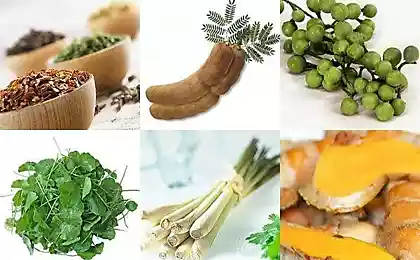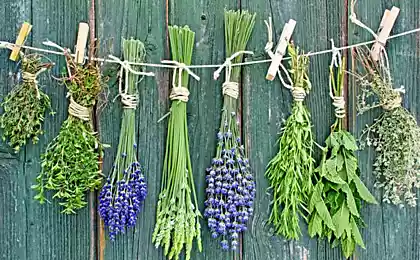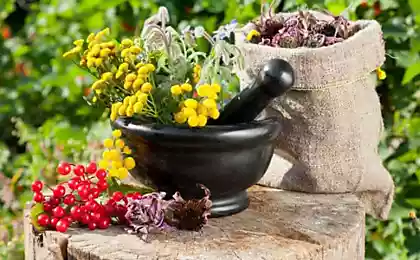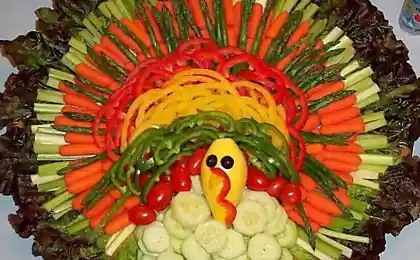319
When and how to harvest medicinal plants + video
Many gardeners collect and dry medicinal herbs. Someone likes to drink aromatic and healthy herbal tea in winter, someone uses medicinal plants for hair and skin care, someone has proven recipes for herbal fees for various ailments. Regardless of the goals, it is important to harvest and dry the plant raw materials properly, and now is the time to remember how to do it.
Each medicinal plant has its own harvest time. It is at this time that it maximizes the useful substances that cause its healing effect. A short calendar table will help to orient in the timing of the collection of plant raw materials (the calendar for the Middle band; for other geographical zones, of course, you need climate-related amendments). To enlarge the image, just click on the picture. :
If the plate is not at hand, or there is no plant of interest in it, we are guided by the general rules - depending on the type of medicinal raw materials.
If the raw material is the kidneys of the plant, you need to collect them in early spring (in some plants - since February). You should have time to “catch the moment” when the kidneys have already swelled, but the leaves have not yet begun to bloom. Opening kidneys no longer have value as medicinal raw materials.
The bark of trees and shrubs is also harvested in spring - when the sap movement begins. The period of its preparation ends when the first leaves are unfolded. If the collection time is chosen correctly, the bark is easily separated from the branch.
Most often, the harvesting of leaves is carried out at a time when the plant forms buds or blooms. Less commonly, in the fruiting phase. In plants with wintering foliage (lingonberry, toloberry), autumn collection of raw materials is also possible - after the berries ripen.
If the flowers of the plant are required for medicinal purposes, you should wait for them to bloom completely. Sometimes buds are used, but you should never harvest raw materials from fading and fading plants.
The overground part of herbaceous perennial and annual plants is collected during their flowering or the formation of buds.
In the vast majority of cases, it is recommended to wait for the fruits and seeds to fully ripen. But there are exceptions. For example, ripe rosehip fruits become soft and crumple when collected - they are collected slightly immature. Kalina, ash, sea buckthorn is good to collect after the first frosts.
If the seeds of the plant, having ripened, easily crumble, fly, apply a small trick: on a branch where valuable raw materials ripen, put on a small linen bag and tie it so as not to blow away by the wind. The ripe seeds will pick themselves)
Roots, rhizomes, tubers and bulbs They are dug, as a rule, in early spring, at the time of awakening of plants; in some plants in autumn - when the maximum amount of nutrients accumulates in the underground organs. At the autumn gathering, usually wait until the above-ground part begins to die off (but until its complete death, so as not to err in the definition of the plant).
Summer is in full swing, and lovers of collecting herbs may be interested in reading the article July – harvesting herbs.
How to properly collect medicinal raw materials is important not only the time of collection. It is necessary to properly collect raw materials so that the plant does not harm, and the beneficial properties of herbs are preserved.
As a general rule, the collection of land parts of plants, and especially flowers, is possible only in dry weather. Wait until the dew drops and you can start. Plants containing essential oils are preferably collected in hot, sunny weather, but berries and juicy fruits - in the morning or in the evening.
Going for herbs, arm yourself with scissors or a sharp cutter, a knife. Do not tear the stems with your hands - it is too likely to damage the plant, tear it from the root or break it. Carefully cut only what we need.
By the way, herbalists usually have their own rituals and rules, which reflect a careful and respectful attitude to Nature, which gives us health and strength. But even if you do not turn to herbs with thanksgiving speeches or read conspiracies when starting to collect herbs, accuracy is a mandatory rule for everyone who harvests healing raw materials.
Remember:
Subtleties of collecting various types of raw materials Kidney
Flowers and flowers
Roots, rhizomes, tubers and bulbs
Source: www.7dach.ru
Each medicinal plant has its own harvest time. It is at this time that it maximizes the useful substances that cause its healing effect. A short calendar table will help to orient in the timing of the collection of plant raw materials (the calendar for the Middle band; for other geographical zones, of course, you need climate-related amendments). To enlarge the image, just click on the picture. :
If the plate is not at hand, or there is no plant of interest in it, we are guided by the general rules - depending on the type of medicinal raw materials.
If the raw material is the kidneys of the plant, you need to collect them in early spring (in some plants - since February). You should have time to “catch the moment” when the kidneys have already swelled, but the leaves have not yet begun to bloom. Opening kidneys no longer have value as medicinal raw materials.
The bark of trees and shrubs is also harvested in spring - when the sap movement begins. The period of its preparation ends when the first leaves are unfolded. If the collection time is chosen correctly, the bark is easily separated from the branch.
Most often, the harvesting of leaves is carried out at a time when the plant forms buds or blooms. Less commonly, in the fruiting phase. In plants with wintering foliage (lingonberry, toloberry), autumn collection of raw materials is also possible - after the berries ripen.
If the flowers of the plant are required for medicinal purposes, you should wait for them to bloom completely. Sometimes buds are used, but you should never harvest raw materials from fading and fading plants.
The overground part of herbaceous perennial and annual plants is collected during their flowering or the formation of buds.
In the vast majority of cases, it is recommended to wait for the fruits and seeds to fully ripen. But there are exceptions. For example, ripe rosehip fruits become soft and crumple when collected - they are collected slightly immature. Kalina, ash, sea buckthorn is good to collect after the first frosts.
If the seeds of the plant, having ripened, easily crumble, fly, apply a small trick: on a branch where valuable raw materials ripen, put on a small linen bag and tie it so as not to blow away by the wind. The ripe seeds will pick themselves)
Roots, rhizomes, tubers and bulbs They are dug, as a rule, in early spring, at the time of awakening of plants; in some plants in autumn - when the maximum amount of nutrients accumulates in the underground organs. At the autumn gathering, usually wait until the above-ground part begins to die off (but until its complete death, so as not to err in the definition of the plant).
Summer is in full swing, and lovers of collecting herbs may be interested in reading the article July – harvesting herbs.
How to properly collect medicinal raw materials is important not only the time of collection. It is necessary to properly collect raw materials so that the plant does not harm, and the beneficial properties of herbs are preserved.
As a general rule, the collection of land parts of plants, and especially flowers, is possible only in dry weather. Wait until the dew drops and you can start. Plants containing essential oils are preferably collected in hot, sunny weather, but berries and juicy fruits - in the morning or in the evening.
Going for herbs, arm yourself with scissors or a sharp cutter, a knife. Do not tear the stems with your hands - it is too likely to damage the plant, tear it from the root or break it. Carefully cut only what we need.
By the way, herbalists usually have their own rituals and rules, which reflect a careful and respectful attitude to Nature, which gives us health and strength. But even if you do not turn to herbs with thanksgiving speeches or read conspiracies when starting to collect herbs, accuracy is a mandatory rule for everyone who harvests healing raw materials.
Remember:
- We never dig up rhizomes of rare (and especially - listed in the Red Book) plants.
- We do not collect everything that we see cleanly – we necessarily leave our natural healers the opportunity to live on and reproduce.
- Do not tear grass with the root, if you need only stems or inflorescences.
Subtleties of collecting various types of raw materials Kidney
- Birch buds are harvested, cut together with branches, and after drying, thrushed and cleaned of impurities;
- Pine buds are cut with a sharp knife, and the buds of aspen, black poplar are gently cut off with their hands.
- Bark collection is carried out only on young (aged not more than 3-4 years) shoots and trunks;
- bark for collection is suitable only smooth, young - in the old there are few useful substances;
- The bark is removed only from the branches, but not from the trunk.
- the bark is removed as follows: two semi-ring incisions on the selected branch (at a distance of 20-30 cm from each other) are connected with two longitudinal incisions and carefully remove the formed strip;
- It is necessary to collect the bark only from well-known plants, so as not to make a mistake (the time for collecting the bark usually falls on the time when there are no leaves on the plant yet).
- The leaves are cut off with hands (movement from top to bottom along the shoot) or cut with scissors (sector);
- thick stems from leaves it is desirable to separate - there are practically no nutrients in them, and they slow down drying;
- collect only healthy, not damaged by pests leaves;
- small leathery leaves (for example, lingonberries, chicks) are collected together with twigs, and then separated from them;
- For collection, well-developed leaves with the lower or middle part of the shoot are preferred.
Flowers and flowers
- flowers and inflorescences are collected by cutting with scissors or gently plucking the peduncles;
- This is a very delicate raw material, so it is recommended to use baskets for collection, in which flowers are laid in a loose layer, without breaking down.
- the above-ground part of the plants during harvesting is cut or mowed at the level of the lower leaves;
- in tall plants with a thick, coarse stem (wormwood, motherwort and others) only the upper parts of the stem (up to 15-20 cm) and lateral shoots are collected.
- Seeds and fruits are picked selectively because they usually ripen unevenly.
- crumbling seeds (for example, anise, coriander, cumin and other plants) can be harvested by cutting off the tops of plants with immature seeds - they are tied in bundles and suspended for dosing, and then thrushed;
- juicy berries (strawberries, currant, blueberries and others) are harvested carefully, shifting each layer of berries (not thicker than 5-7 cm) with a layer of leaves so that the raw material is not tracked - the crumpled berries deteriorate, rot or are covered with mold when dried.
Roots, rhizomes, tubers and bulbs
- underground parts of plants are dug out with a pitchfork or shovel along with the soil, and then, having shaken the ground, washed in cold running water;
- washed raw materials are laid out to slightly dry, and then cleaned of debris, damaged parts, small roots;
- It is impossible to wash underground parts of plants containing mucous substances and saponins (jawthorn, bruise and others) - the ground from them is carefully shaken off and removed from the roots (tubers, rhizomes) of the upper skin.
Source: www.7dach.ru




















